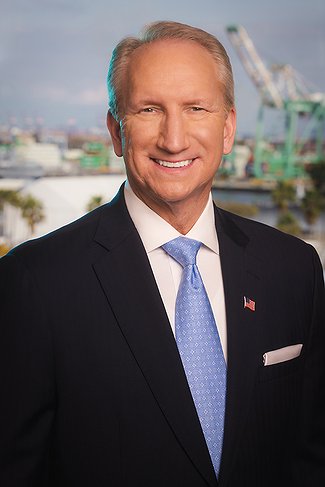Record-breaking stats for the Port of Los Angeles: July was the busiest in its history and year to date has processed more container units than any other port in the Western Hemisphere. | Photo courtesy of Port of Los Angeles
FREIGHT & LOGISTICS
Port of L.A. Media Advisory Highlights Achievements, Sustainability Efforts
If Halloween seems to have come early this year to your local retailer, well, Christmas may not be far behind. The Port of Los Angeles handled a record-breaking 939,600 Twenty-foot Equivalent Units (TEUs) in the month of July, a 37 percent increase over the previous year, making it the busiest July in the port’s 116-year history as well as the busiest month in over two years. Seven months into 2024, the port has processed 5.6 million container units, 18 percent ahead of its 2023 pace and more than any other port in the Western Hemisphere.
The record-breaking numbers were announced this week at a media briefing held Aug. 13. “We’ve seen an influx of year-end holiday goods coming across our docks earlier than usual to avoid any risk of delay later in the year,” said Port of Los Angeles Executive Director Gene Seroka. “These goods—including clothing and footwear—are arriving at the same time as more typical back-to-school, fall fashions and Halloween merchandise. An early peak season has helped boost volume here, and I’m grateful to our stakeholders, who work tirelessly every day to move all this cargo with remarkable speed and efficiency.”
Retailers are fueling a summer rush of imports this year as they guard against a potential strike by port workers on the East Coast, ongoing shipping disruptions from attacks in the Red Sea and the late date for Thanksgiving, which falls on Nov. 28, shortening the peak shopping and delivery season running through Christmas Eve.
The press briefing also included Paul Bingham, an economist with S&P Global Market Intelligence, who discussed global supply-chain issues as well as economic forecasts. “We have an overall slowdown in the pace of growth as we head into 2025,” Bingham said, “where the economy is slowing from a pace of 2.6 percent. It will still be an economy that is growing but not at the pace of the first half of this year.”
As for recession fears, Bingham largely calmed them. “There’s been a lot of concern in the last few weeks, but our macro economists do not have their baseline forecast of a recession this year or next year. We think it will be avoided and the Federal Reserve Board will succeed in having a soft landing that keeps the U.S. economy growing even as the pace downshifts a bit in 2025.”
Breathing easier
Angelenos can also breathe easier knowing the increasing port traffic is being offset by aggressive sustainability targets, the most ambitious of all the world’s seaports. In response to a question from the California Apparel News, Seroka explained the port’s strategies in the wake of a recent $500 million grant from the Environmental Protection Agency. The EPA is doling out nearly $4.3 billion in climate grants, with the largest allocation going to the South Coast Air Quality Management District, which is responsible for reducing air pollution in the nation’s smoggiest basin. It is the largest grant the federal agency has ever awarded to combat air pollution.
“It’s my estimation that to get to the port’s goals of 2030 zero-emissions cargo-handling equipment and 2035 zero-emissions heavy-duty trucks is about a $20 billion price tag,” Seroka said. “Now, some want to decarbonize the supply chain across Southern California, and we support that goal all out, but that price tag could be $80 billion.”
Much of the technology associated with zero emissions is brand new, and the cost of new infrastructure almost matches the price of the cutting-edge environmental innovations. “For example, a battery electric truck right now selling for $450,000 needs that amount of money invested for infrastructure to keep that truck charged,” Seroka explained. “And we’re spreading this out through a number of segments in the supply chain, so it’s going to be a public-private partnership that carries us, focused on key commerce corridors.”
About a third of cargo imported through the port is trucked to places in the Inland Empire such as Fontana and Ontario, Seroka said, some 50 to 75 miles from the port complex. “We have to make truckers confident that they’ll get a charge of electricity or hydrogen for their engine.
“And if we look at all five major categories of pollution,” Seroka continued, “ships are number one, and that’s one of the reasons we started the Green Shipping Corridor. In one of our most heavily traveled trade lanes from Shanghai, if we could reduce pollution by 10 percent that would be equivalent to all the pollution at the Port of Los Angeles in one year. So we’re not going to be able to paint a green brush across our geography and say ‘we’re going zero emissions.’ It takes the hard work of scientists, engineers, thought leaders and the ability for private-sector companies to follow investments like the EPA’s $500 million with the confidence that they can maintain their standing in this market.”
The Port of Los Angeles has its own application in to the office of the EPA, Seroka added, for $450 million in grants for infrastructure and equipment vehicles. “We’ve partnered to make that application stand out, and hopefully later this year we’ll hear from the evaluators on our success.”
























